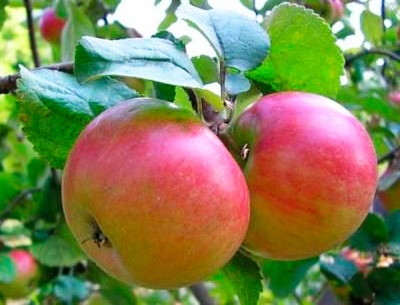
- Authors: P. I. Lavrik, L. A. Zhmurko (Vologda stronghold)
- Taste: sour sweet
- Fruit weight, g: 60-100
- Fruit size: average
- Yield: high, 40-100 c / ha
- Frequency of fruiting: almost annual
- The beginning of fruiting varieties: for 4-5 years
- Ripening terms: summer
- Removable maturity: In the end of August
- Keeping quality: up to 2 months
When planting apple trees in a summer cottage or in a garden, you should select varieties so that there are fresh apples in summer, early autumn, and closer to winter. Not capricious, giving very tasty fruits in the middle of summer, is the apple variety Paper, which is grown by both farmers and novice gardeners.
Breeding history of the variety
The summer variety Bumazhnoe was developed almost 100 years ago. Breeders Lavrik and Zhmurko worked on its breeding, whose goal was to create an apple species that ripens quickly in the short summer season. The seeds of the Borovinka variety were used for the basis of the new species.
Description of the variety
Apple-tree Paper is a medium-sized tree, reaching a height of 3-6 meters, endowed with a rounded crown of moderate density. The tree has a well-developed root system, and the branches are very thin and fragile, therefore, during periods of high yields, they sometimes break off under the weight of the fruit.
Features, pros and cons
Apple tree Paper is a tree that gardeners often grow on their plots. The variety is popular due to its many features:
- immunity to disease;
- high winter hardiness;
- unpretentious care;
- quick survival in different soils;
- good yield indicators.
The disadvantages of the fruit crop include the fragility of the branches, low keeping quality (up to 50-60 days) and the huge dimensions of the tree, which takes up a lot of space on the site.
Ripening and fruiting
Flowering begins at the end of the spring frost, and active fruiting is very extended, it occurs in the second half of August and lasts 3-4 weeks. The apple tree bears fruit annually, and the yield indicators only grow over the years.
Growing regions
Due to its high resistance to frost, heat and drought, the tree is able to quickly adapt and grow in any region of the country. In addition, the Paper apple tree is grown on the territory of Belarus and Ukraine. The tree bears fruit for 4-5 years of growth.
Yield
The yield of the variety is high. More than 80-90 kg of apples can be harvested from one mature tree per season. Yields may vary depending on climatic conditions. Manual control of the ovaries on the tree will help to stimulate a stable harvest (excess ones are removed).
Fruits and their taste
Medium-sized apples have an almost white color with a bright red blurred blush, a firm and smooth skin, delicate flesh and high juiciness. The mass of one fruit of the correct rounded shape is 60-100 g. The apples taste sweet and sour, and the sourness is pronounced. The fruit is remembered not only for its taste and juiciness, but also for the aroma that the tree exudes during the flowering period, as well as the apples themselves.

Growing features
To plant paper seedlings, you will need a carefully selected area, which must be dug up to improve air circulation, cleaned of weeds, loosened, fertilize, and provide moderate moisture. Suitable will be a fertile soil of a light loamy or slightly podzolic type.
An important aspect is the deep passage of groundwater, since stagnant water can negatively affect the root system of the seedling. The site should be well lit and closed from drafts and strong winds.
Planting seedlings is possible in early autumn (3-4 weeks before frost) or in spring after warming up the soil, but before bud break.



Pollination
This apple variety needs cross-pollination, therefore, apple trees with a flowering period coinciding with Paper should be grown on the site - Autumn striped, Melba, Antonovka ordinary.
Top dressing
Correct care involves feeding. In the autumn period, potassium-phosphate fertilizers are applied for digging, and in the spring, before bud break, nitrogen substances will need to be added.

Frost resistance
The variety is quite frost-resistant, so low, high and prolonged frosts are not terrible for the tree. Trees are able to withstand temperatures down to -30-35 degrees, which will not affect development and fruiting. In case of prolonged frosts, it is necessary to insulate the trunk, the near-stem zone and the root system using mulching.

Diseases and pests
Due to its good immunity, the apple tree is not exposed to scab and powdery mildew, however, the immune system is weak to fruit rot. To prevent diseases and pests, it is recommended to carry out preventive actions - spraying. In addition, in regions with high humidity and dampness, it is necessary to monitor the condition of the crown throughout the season.

The apple tree is a popular fruit crop among gardeners. It can be found in many summer cottages. But at the same time, such trees are often affected by various diseases.It is very important to recognize the disease in time and carry out the necessary procedures for a speedy recovery. Otherwise, the fruits will be spoiled, and the tree itself may die altogether.

Review overview
Yablonya Paper is a frequent visitor to the backyards of novice gardeners, as well as farmers who grow fruits on an industrial scale, so there are a lot of reviews about the variety.
Most gardeners note the high taste of fruits, to which the bright sourness gives piquancy, unpretentious care (the exception is additional insulation during prolonged frosts), as well as resistance to diseases.











































































